 By Toby, Exeter Cathedral Work Experience Student
By Toby, Exeter Cathedral Work Experience Student
Devon may not be the first location you think of when talking about natural history, but while it does not contain the vast quantities of impressive fossils and natural sites of North America, it still has interesting natural history, including locations such as the Jurassic coast and Exeter Cathedral.
The reason I mention Exeter Cathedral is because of the materials used in its construction: Salcombe stone, which may be 415 million years old, and volcanic trap, which is lava that has cooled and hardened. Both are found in the Cathedral’s walls. Devon even has a historical period named after it: the Devonian period, known for the iconic red sandstone cliffs seen along Devon’s coastline and the fossils found inside of them.
While Devon may not have a Tyrannosaurus or Triceratops, it has some interesting fossils and prehistoric creatures, such as Baryonyx, Megolosaurus and Iguanodon. The region’s natural history, specifically its fossils, inspired many historical figures, including Mary Anning of Lyme Regis. It also inspired Sir Joseph Paxton’s geological feature at London’s Crystal Palace Park – a Victorian public display of life-size sculptures of prehistoric animals. While wrong in their ideas of what dinosaurs looked like, the models serve as a time capsule of early paleontological and biological knowledge.
The same can be said of some books in the Cathedral Library, such as Historia animalium, written by Conrad Gessner as an encyclopaedic inventory of Renaissance zoology, and featuring both real and mythical creatures, such as unicorns. However, there is some controversy as to whether Gessner intended to add mythical creatures; some theories state that it may have been done by the publisher to boost sales and to allow for monetisation in curio markets where, for example, dried rays were presented as dragons. Gessner also reproduced a famous 15th century woodcut of a rhinoceros by Durer, which portrayed the rhino as having armour plating covering its body, scaly legs and with an additional twisted horn sticking out from its back. The woodcut was based on a written description and a quickly drawn image but for centuries people believed that this is what a rhino looked like.